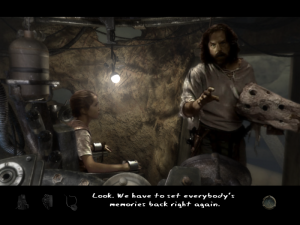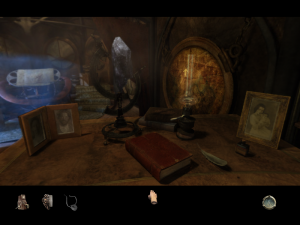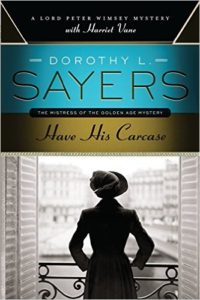 I fell in love with the Myst games a long time ago. The photo-realistic worlds and the tantalizing hints of deeper things always left me wanting more.
I fell in love with the Myst games a long time ago. The photo-realistic worlds and the tantalizing hints of deeper things always left me wanting more.
Until now. Myst IV: Revelation has…finished Myst for me. It is concluded…I am satisfied. And for once, I don’t need to weep at the parting. (Well, maybe just a little.)
The World
The central premise of Myst is that a civilization called the D’ni could create worlds by writing books, and then visit those worlds physically by linking through the books. (A person must bring a return Linking Book with him when he goes exploring, and any book you link through doesn’t come with you – it stays in the first world.)
From a first-person perspective, we point and click our way through these “Ages” to unlock doors, uncover passwords, power machines, and solve puzzles. And, of course, soak in breath-taking landscapes, vistas, and architecture.
Whatever else I can say, the world is still incredible. Hydraulic locks, levers and buttons, rotating bridges and elevators…it’s like an engineer’s playground. These real-world mechanics mix, of course, with magic crystals, strange animals, bizarre cultures, and the Age-writing Art of the D’ni.
The Progress of Technology
Myst was released in the dark ages of computing, when graphics cards were limited, the in-game animations were tiny and limited, and the curser was a 2D hand (that changed shape for different interactions).
Revelation seeks to take full advantage of the progress of computer technology, and offers a 360º, 3D-rendered environment to explore.
This means that the world around you doesn’t always look as photo-realistic as it did in Myst, or Riven. The camera also has a tendency to focus in on the foreground, or the background, depending on where your cursor is. I think this is to mimic the variable focus of the human eye, but it’s distracting.
As for the cursor, it’s a 3D, CGI hand. It waves vaguely wherever you point it; extends the fingers to indicate a direction you can move; whips out a magnifying glass if something can be examined more closely; and stretches the fingers subtly if you can unroll a map, pull a lever, or other similar action. This final characteristic can be easy to miss, and if it’s not obvious something is there to manipulate, you can easily miss some interactions.
Atrus’s Family
If you haven’t yet played Myst or Riven, SPOILER ALERT! (Also, go do that.)
Way back in Myst, we met two characters trapped in books that they had thought were Ages: Sirrus and Achenar. Their dad is Atrus, and he is a descendent of the fallen D’ni civilization and a writer of Ages.
If you played through Myst, explored the Ages that link from it, solved Atrus’ pretty un-secure password manager, and uncovered the truth about what happened…you’ll know that Sirrus and Achenar trapped their father without a Linking Book home, distracted their mother, burned most of Atrus’ library of Books, and used the special Books he had warned them never to touch.
Blam! The books trapped them. And once you free Atrus, he burns those books to keep them from ever escaping.
Until now.
Revelation!
Fast forward twenty years. Atrus invites you (his nameless, faceless, gender-less “friend”) to his new home, where he is attempting to spy on the Prison Ages and decide if his sons have repented of murdering the inhabitants of the Ages and are ready to be released.
Yes…we can see this ending well, eh?

Image from Pixabay
Turns out, he and his wife have already written visiting capsules into the Prison Ages. That way, they can link into the capsule, have a visit through bars, and link away – leaving the Linking Book for their own home out of the reach of the prisoners.
The prisoners can’t possibly escape! Why would you worry about that? Atrus only built complex machinery and houses and scientific equipment by hand in his various Ages…what makes you think his sons could do the same thing from scratch?
Yeesha
Did I mention? Atrus also has a ten-year-old daughter now.
Maybe it’s her dialogue, or maybe it’s the delivery of the actress, but Yeesha is clearly supposed to capture our sympathies and feel like a dear friend (even though we’ve actually only just met). Y’know, one of those annoyingly perfect child-characters.
Especially as the “mysterious circumstances” start piling up, you really start to feel that Atrus is a clueless dupe who should have stuck to books, and not attempted children.
Puzzles
I should say something about the puzzles.
We have our classic Myst fare here, with locked doors; passwords in journals; machines that need power; etc.
It made me wonder if Atrus has a constellation-based color-combination lock on the bathroom…and then I realized that his house has no bathroom.
Also contains one or two pixel-hunts, although that might be due to the mechanics of the cursor-hand (see above).
Messin’ with Memory
Added to those familiar hurdles is a new mechanic. Yeesha has a magic necklace that shows memories.
This, along with the journals that every member of Atrus’ family conveniently keeps, lets you piece together the motives of the various actors, solve some of the puzzles, and generally be the worst thing to happen to Sirrus and Achenar!
M’whahaha! If you wanted to forge an evil plot, you shouldn’t have invited the Stranger-from-the-Starry-Void!
Seriously, though, this mechanic gives you hints for solving the puzzles, plus valuable information at unraveling the sinister plot being woven.
Who is plotting what? Who is evil? And who should I trust?
Being able to view people’s secret memories is very handy for that…
A note on story tension
My family mocked me for this, but I’ll bring it up anyway.
Whenever you linked to new Age in Myst, you had to solve the Age’s puzzles and get things working again to unlock the Linking Book and return to Myst.
In Riven and Exile, you plunged into an unknown world without a ticket out, and had to solve your way forward to find any way to escape. (And in Riven especially, Atrus’ wife’s fate hangs on your success.)
In Revelation…your first task is to “oh, get the power back on, will you?” Your second task is, “Feel free to check out my Linking Books if you like…oh, and make sure Yeesha does her homework.” Ha ha.
Beyond that, though, every single place you visit has a Linking Book back to Atrus’ home right there at the beginning. You don’t need to venture into predator-infested jungles, or brave bottomless shafts in wind-swept fortresses…you can say, “Forget this,” and hop back home.
Obviously, I bought this game in order to play through the puzzles, and feel smart, and uncover the story through journals and clues. And my family helpfully pointed out that this gives the game a less linear structure. You can solve this Age, or that Age, or stay and futz around the first Age…or jump to this new Age…
Solve puzzles in whatever order you want. Travel when and where you want. Stop and go back to a place you especially liked if you really want.
True, this gives the player much more freedom in how they play and the order they play puzzles in (and the sequence in which they unravel the story).
However, it also saps some of the urgency from the story. You are not trapped, and hunting for an escape. Later on, you’re kind of searching for Yeesha, and trying to uncover what happened…but it’s not like there’s a rush. There’s plenty of time to ransack the Ages for anything marked PRIVATE DIARY. And, well, there’s not the same level of narrative tension.
(Perhaps if I hadn’t thought Yeesha was an annoying Mary Sue who was also try to kill me via collapsing bridge, I would have felt more invested in the rescue mission. But again, when I could back out at any time and return to Atrus’ house… “Hey, I’ll make some tea or whatever your culture drinks…Hope it all works out, Atrus! Maybe you should spend more time supervising your children than leaving them in the care of your ‘friend’ and dashing off for machine parts.”)
Serenia…or, the 1960s New Age-y Age
Revelation gives you four Ages to explore. The final one is Serenia.

As if the rest of it wasn’t weird enough…
The outside of Serenia is beautiful — full of twisty, hard-to-map paths; flowing, conjoining streams of water; butterflies that look like organza pixies; and trees that release dandelion-poofs on the wind.
The inhabitants’ culture is based around giant mushrooms that store people’s memories when they die, so their loved ones can travel to a mental space called “Dream” and “visit” the dead ancestors again.
(As one of the female tenders of the mushroom says: if you don’t heal the “Memory Chamber”, “we may never be able to visit our loved ones again!” I bleed for you says the gal from a world where people stay dead…and we don’t have memory spheres to help hallucinate a spirit visit.)
Back to the culture, the “Protectors” have somehow seen your arrival prophesied (y’know, you – the protagonist) and help you find a spirit guide (from the air, fire, or water spirits that play in the forest) so you can travel to Dream and find out who kidnapped Yeesha.
They also wear a stripe of face-paint down their noses (and have creepy, African-esque masks). And the puzzle in Dream is like musical color-matching on evil steroids!
Atrus was always an apologetic, kinda nerdy guy…but lately he seems to just assume you’ll help dig him out of whatever hole he’s gotten himself in. And these all-knowing chicks in Serenia are even more pompous and touchy-feely.
Even if I hadn’t heard such dismal things about Myst V: End of Ages…this “New Age” spiritualism is enough of a departure from the original heart of Myst (nuts and bolts, analog passwords, and the science-based “magic” of the D’ni Art) to make Revelation my last Myst game.
Climax Catharsis
Yet I said I was satisfied. Why am I satisfied?
Well, without laying bare the resolution…the climax of Revelation hinges on you choosing to believe one of Atrus’ children over another. This choice is based on what you have learned by reading their journals, listening to their memories, and piecing together the Evil Plot (and who is probably responsible for it).
Got the right answer the first time. (Thank you, thank you, no need to clap.) And the conclusion that is spun from that –logically, inexorably – brings the plot-line to a perfect and reasonable end.
While the writers did a bit of ret-conning to bring Sirrus and Achenar back into the story, the way they handled the two of them (and Yeesha) was believable, appropriate, and entirely conclusive.
In a way, they un-did the ending of Myst…and yet, in another way, they built onto it so naturally and understandably that Revelation is really a good end for Myst – the game and the series.
My Last Myst Game
When I played through Myst again several years ago (in the updated and expanded RealMyst version), I loved the Ages and the visuals as much as I always had…and left hungry to play Riven.
I re-played through Riven: The Sequel to Myst, and I loved it even more than Myst (not only is it longer and more complex, but it feels like less of the history is buried or off-screen). It also left me longing to play Myst III: Exile.
I have not yet played through Exile a second time, but I know it left me eager to try Revelation.
And now…
Part of it is the bad reviews my brother tells me about from Myst V, and part of it is…the story is complete.
I have scratched my first-person point-and-click itch. Myst created a game type never before seen…and now Revelation has brought the story and the world full-circle.
The ending is bittersweet, poignant, and appropriate. It is also, I think, The End.
(Though I already bought Obduction, which is by the same developers/writers, but set in a different universe. We’ll see how that one pans out…)
As always, I highly recommend the Universal Hints System to give you just the help you need…and no more.
In Myst IV: Revelation, the next chapter in the greatest adventure saga of all time, you’ll travel through environments pulsing with life to unearth a treacherous scheme involving two of Myst’s most sinister villains.
Find the game on GoG.com (DRM-free!), Steam (which includes DRM in their software), and on Amazon if you really need a disk (though paying over three times the price for digital download sounds ridiculous).
Wish-list it on GoG to be emailed when it goes on sale!












